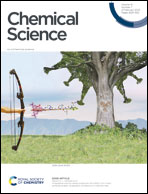Free radicals promote electrocatalytic nitrogen oxidation†
Abstract
In this work, we introduce hydroxyl radicals into the electrocatalytic nitrogen oxidation reaction (NOR) for the first time. Cobalt tetroxide (Co3O4) acts not only as an electrocatalyst, but also as a nanozyme (in combination with hydrogen peroxide producing ˙OH), and can be used as a high-efficiency nitrogen oxidation reaction (NOR) electrocatalyst for environmental nitrate synthesis. Co3O4 + ˙OH shows an excellent nitrogen oxidation reaction (NOR) performance among Co3O4 catalysts in 0.1 M Na2SO4 solution. At an applied potential of 1.7 V vs. RHE, the HNO3 yield of Co3O4 + ˙OH reaches 89.35 μg h−1 mgcat−1, which is up to 7 times higher than that of Co3O4 (12.8 μg h−1 mgcat−1) and the corresponding FE is 20.4%. The TOF of Co3O4 + ˙OH at 1.7 V vs. RHE reaches 0.58 h−1, which is higher than that of Co3O4 (0.083 h−1), demonstrating that free radicals greatly enhance the intrinsic activity. Density functional theory (DFT) demonstrates that ˙OH not only can drive nitrogen adsorption, but also can decrease the energy barrier (rate-determining step) of N2 to N2OH*, thus producing great NOR activity.



 Please wait while we load your content...
Please wait while we load your content...